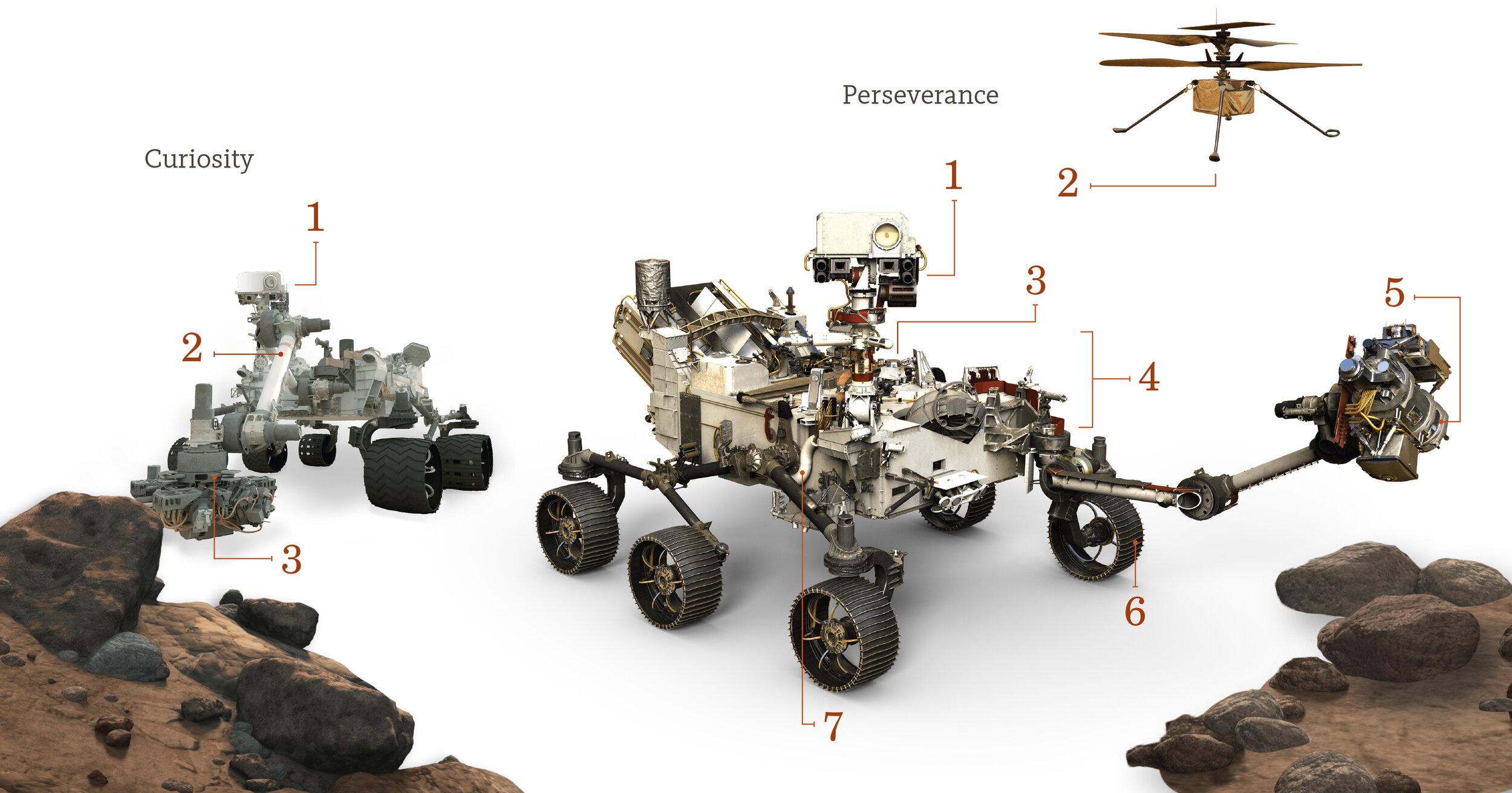Mars 2020: Evolution of a Rover
This summer, the Mars Perseverance rover will set out to join Curiosity on the Red Planet. The two rovers, both built by JPL (which Caltech manages for NASA), share many design features but play different roles in the ongoing exploration of Mars and the search for ancient life. They also differ in important mission-specific ways: while Curiosity has identified and continues to study environments where ancient microbes could have lived, Perseverance will seek direct signs of ancient life and prepare geological samples that a future mission could bring back to Earth.
Curiosity
Curiosity has seven cameras on its mast; two of them are color cameras. These two cameras, making up the mast camera, or Mastcam, have taken stunning color panoramas of the Martian landscape.The rover’s arm extends 2 meters and wields a rotating 30-kilogram turret equipped with a scientific camera, chemical analyzer, and drill.
Curiosity collects rock samples and studies them in its onboard laboratory. The rover is currently ascending the 5-kilometer-tall Mount Sharp, which sits within Gale Crater and was partially formed by water.
Some of Curiosity’s key discoveries include uncovering evidence of ancient lakes on Mars and, with the help of a drill on its robotic arm, finding chemicals necessary for life, including sulfur, nitrogen, oxygen, phosphorus, and carbon.
Perseverance
Perseverance will have the most advanced set of “eyes” ever sent to the Red Planet. It has a total of 23 cameras, most of them color, as well as two microphones to capture, for the first time, the sounds of a Mars landing and the Martian wind. Mastcam-Z, an improved version of Curiosity’s mast camera, has zoom capability and the ability to take high-definition video and panoramas, and improved 3-D imagery.
A small helicopter drone is attached to the belly of Perseverance, where it will stay protected during the landing. Once on Mars, it will test powered flight on another planet.
An enhanced brain will permit Perseverance to figure out its path on Mars autonomously up to five times faster than Curiosity. Team members hope this will reduce the amount of planning time needed for navigation, allowing the new rover to cover more ground and accomplish more tasks.
The chassis, or body, is about 12 centimeters longer than Curiosity’s. It is also heavier at 1,025 kilograms compared with Curiosity’s 899 kilograms.
Perseverance’s arm has the same reach as Curiosity’s, but its turret, at 50 kilograms, weighs more because it carries larger instruments and a larger drill for coring as it looks for signs of past life. The drill will cut intact rock cores in the Jezero Crater, the site of a former lake, which could then be retrieved by future missions and returned to Earth for in-depth study.
The wheels are made from the same material as Curiosity’s but are bigger and narrower, with thicker skins. Instead of Curiosity’s chevron-pattern treads, Perseverance has straighter ones and twice as many per wheel. Testing in JPL’s Mars Yard (a simulated Martian landscape) has shown these treads better withstand the pressure from sharp rocks while continuing to manuever well on sand.
MOXIE, an oxygen-generating instrument the size of a car battery, will demonstrate how future explorers could produce oxygen from the Martian atmosphere.
Learn more: Where to Land Mars 2020: A Conversation with Ken Farley

